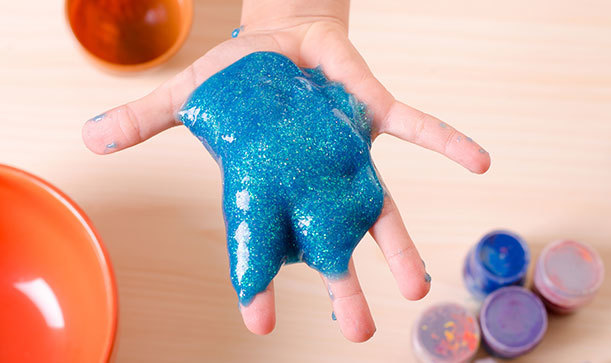BOOMBox at Home: Ingredients of Slime
February 24, 2021

This week, we’re exploring the ingredients and science of slime, as well as how to make your own goopy batch.
Science of Slime
Have you ever wondered what slime is? What makes it such so squishy and fun? What chemicals make it happen? Well, look no further: learn all about the science of slime.
Slime flows like a liquid, but unlike familiar liquids like oil and water, its ability to flow (also known as its viscosity) is not constant. Because slime doesn't react to hot or cold as water or ice cream does, it's considered "non-Newtonian" because its viscosity can be changed by squeezing, stirring, adding pressure, and more. This means when you pour slime or let it ooze through your fingers, it has a low viscosity and flows like a thick liquid. When you squeeze a non-Newtonian slime, like oobleck, it feels hard, almost like a wet solid. This is because applying stress squeezes the particles in the slime together, making it hard for them to slide against each other.
Most types of slime are also examples of polymers. Polymers are large molecules made up of many smaller molecules layered together in a repeating pattern. So, to make slime, you basically mix chemicals together until they form polymers. If you’ve ever made slime, you’ve probably seen this happen when you mix glue and Borax together.
These videos and articles dive more into the ingredients and science of slime:
Types of Slime
There are many types of slime--crunchy, magnetic, glittery, fluffy, and even slime you can actually eat--but remember, not all slime is edible! There’s also putty, gak, oobleck, and hundreds of others. Oobleck is a mixture of starch and water. Gak is similar to slime but is cloudier, thicker, and more like putty. Other types of slime are mainly oils rather than water, like Silly Putty and electroactive slime.
The main ingredients for all types of slime include some type of glue, water, activator, and add-ins. The main ingredient in slime, Borax, also called sodium tetraborate, is a powdery white mineral that has been used as a cleaning product for decades. Other than borax, some popular activators used in slime recipes include liquid starch, eye drops, eyewash, and contact lens solution. Some typical add-ins are food coloring, glitter, fake snow, confetti, foam or glitter beads, and essential oils.
Learn more about the different types of slime:
- The Ultimate Collection of Types of Slime from A to Z
- Recipes for Making Different Types of Slime
- 51 Easy to Make Slime Recipes
How to Make Simple Slime
Now that we’ve learned about the science behind slime and how many types of slime there are, let’s begin by making a classic slime recipe that is virtually foolproof.
Ingredients
- ¼ teaspoon of Borax powder
- ½ cup of clear or white glue
- 1 cup of water split into two ½ cups
- Food coloring
- A bowl, a spoon, and measuring cups
Instructions
- Dissolve ¼ teaspoon of Borax powder into ½ cup of warm water in a bowl. Mix thoroughly.
- In a second bowl, combine about ½ cup of glue and mix with ½ cup of water and mix well.
- Add a couple drops of your preferred food coloring to the second bowl.
- Pour the borax and water mixture into the glue and water mixture and stir. It will seem stringy and clumpy.
- Remove it from the bowl and knead it for a couple of minutes until it’s smooth and stretchy. Store it in a reusable container to keep it stretchy for as long as possible.
Is your slime too sticky, too hard, or too watery? Have no fear, the Slime Troubleshooting Guide is here! A lot of chemistry goes into making slime, so you won’t always have a perfect batch. The troubleshooting guide will show how you can fix your slime to make it perfect.
Learn how to make edible and nontoxic slime without any harsh chemicals:
Ingredient of the Week
Just like glue can be used for many things, chickpeas can, too. If you have a sweet tooth, try making these chickpea blondies. If you prefer savory foods, try these roasted chickpeas that perfect for a snack or salad topper.
Scientist of the Week
Kenneth Kamrin is a professor of mechanical engineering at the Massachusetts Institute of Technology (MIT). He received a bachelor's degree in engineering physics at UC Berkeley in 2003 and a PhD in applied mathematics from MIT in 2008. Kamrin’s primary work focuses on understanding the flow of granular materials, such as sand. He’s developed a mathematical model that accurately predicts the flow of dry grains under a number of different conditions and environments.
Recently, Kamrin and his team created the first 3D computer model that can predict the seemingly mysterious behavior of oobleck, possibly opening doors for serious uses of this substance. In their research, they found that oobleck could be a temporary fill for potholes. On a road with a fast enough speed limit, a bag of oobleck (or oobleck-like material) could be dumped in a pothole, filling the void and transitioning to a solid when run over by car wheels.
Read more about Kamrin’s research, including his findings and discoveries:
Written by Mahnoor.